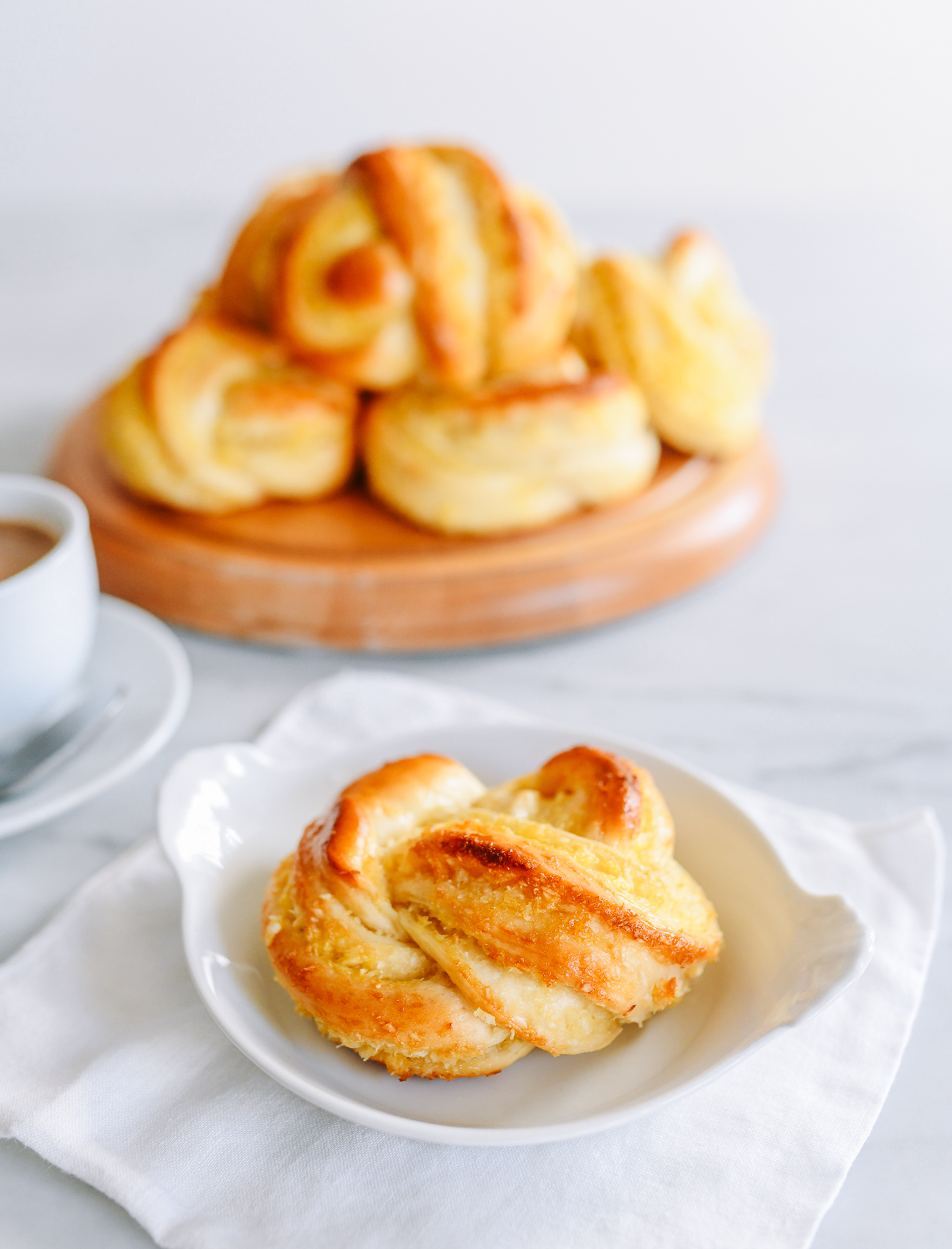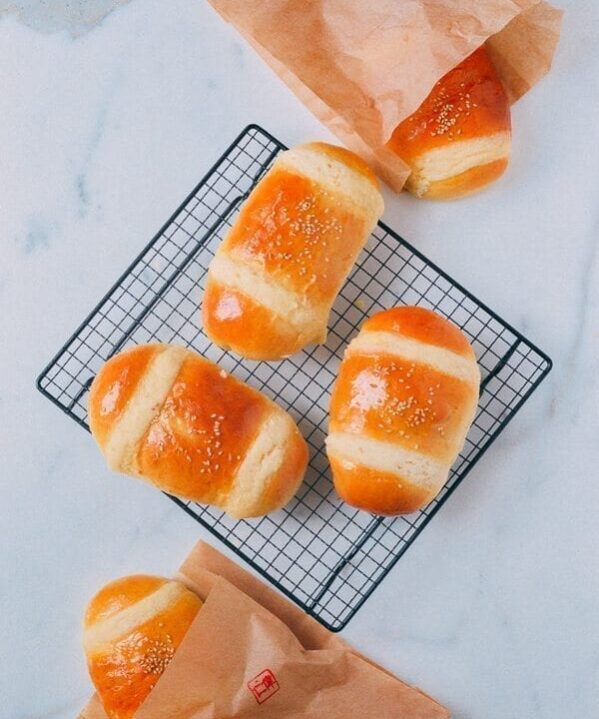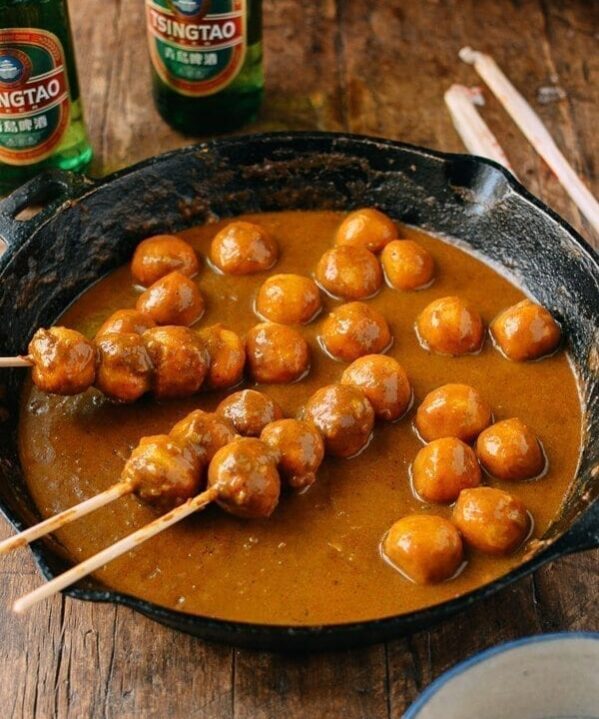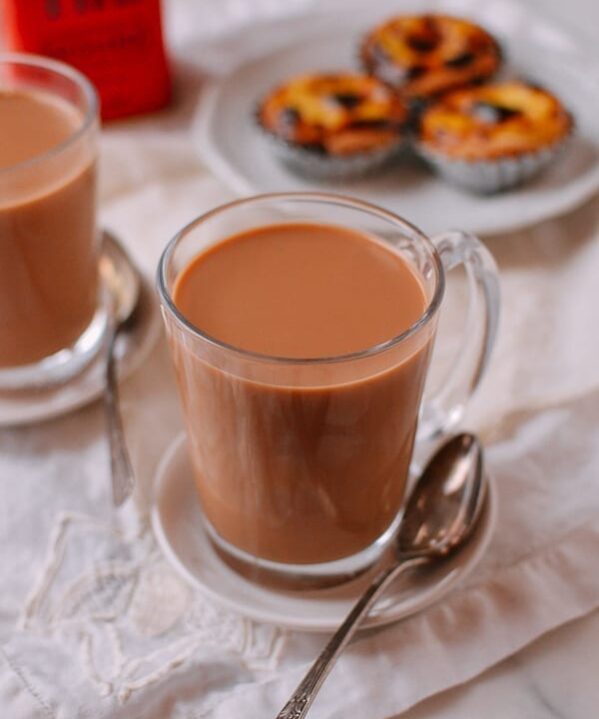Coconut buns, or “cocktail buns” are a beloved bakery favorite among locals in Hong Kong and Chinatowns everywhere. It combines the soft, buttery milk bread ubiquitous around Asia, with a sweet, rich coconut filling.
Often, the filling ends up baked in a big hunk in the center of the bun. When I eat one, I tend to rip off pieces of bread along with bits of filling to get both in each bite. But that got us thinking…what if everything was all evenly distributed to begin with?
We decided to try making these “Inside-Out” Hong Kong Coconut Buns to do just that. They’re so pretty when baked—a swirl of soft bread and sweet coconut. They’re also surprisingly easy to make!
You can also try our more traditional Chinese Coconut Cocktail bun recipe, which is also very good. It’s all up to whether you prefer your filling in the middle of your bun, or spread throughout the bun!
Note: This recipe was originally published in July 2014. We have since updated it with a softer dough recipe (our beloved Milk Bread!), clearer instructions, new photos, metric measurements, nutrition information, and more. Enjoy!
Inside Out Coconut Buns: Recipe Instructions
In the bowl of a stand mixer fitted with the dough hook attachment, add ingredients in the following order: heavy cream, milk, egg, sugar, cake flour, bread flour, yeast, and salt.
DON’T HAVE CAKE FLOUR OR BREAD FLOUR?
Feel free to substitute all-purpose flour for both!
Turn the mixer on to the lowest setting to bring the dough together. Knead on low speed for 15 minutes. If needed, turn off the mixer to bring the dough together with a rubber spatula.
The dough should not stick to the sides of the mixer, but it may look a little bit sticky (sticking to the bottom of the mixer is ok).
If you’re in a humid climate, and the dough is sticking to the sides of the mixing bowl, add more flour 1 tablespoon at a time until it comes together.
Alternatively, you can stir the ingredients together with a wooden spoon in a large mixing bowl, and then knead by hand for 20 minutes.
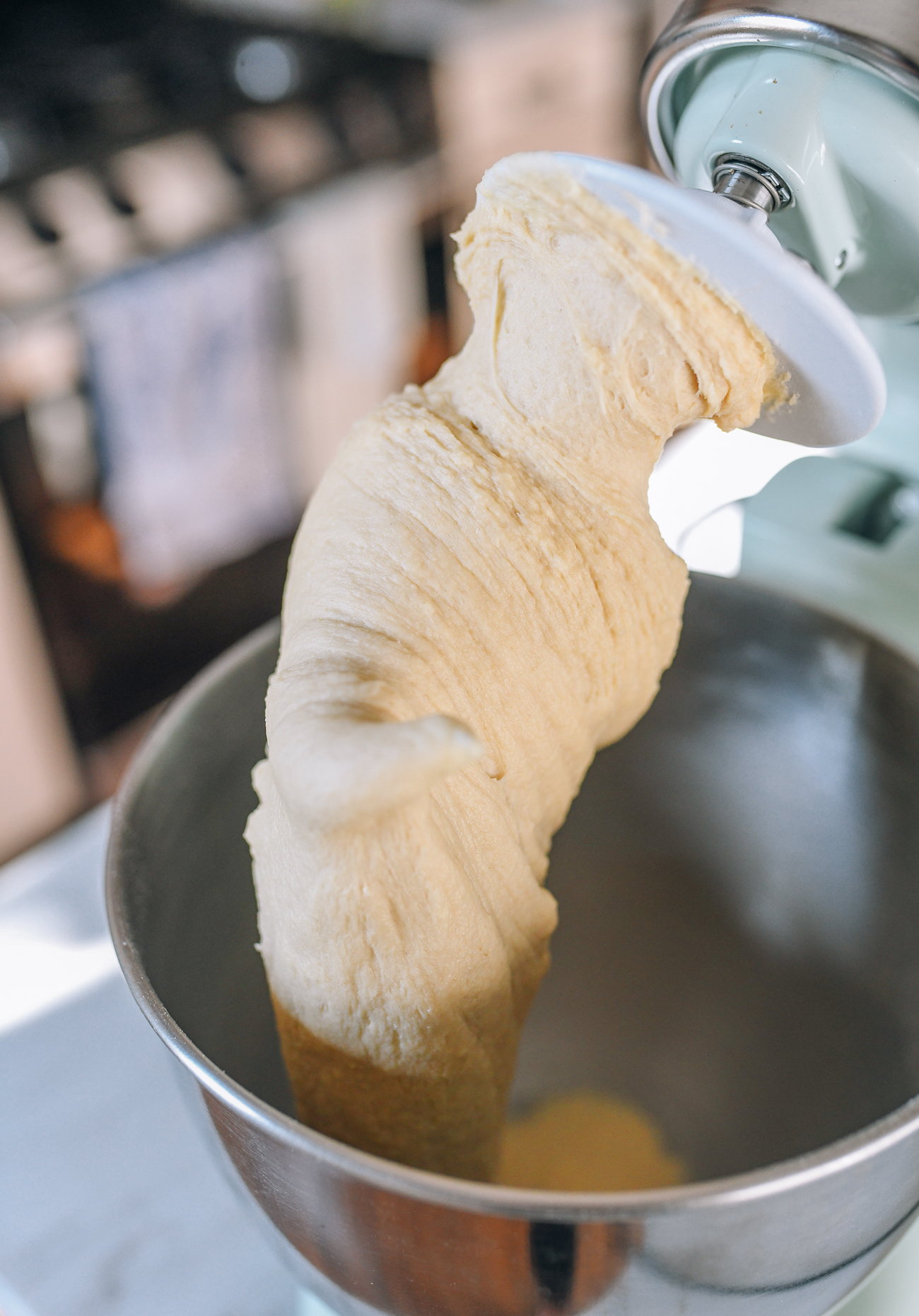
After 15 minutes of kneading, scrape the dough from the dough hook. Cover the bowl with an overturned plate or damp towel, and place in a warm spot to proof for 75-90 minutes, or until the dough doubles in size.
(A good proofing environment is a closed microwave, with a mug of hot boiled water next to the bowl.)
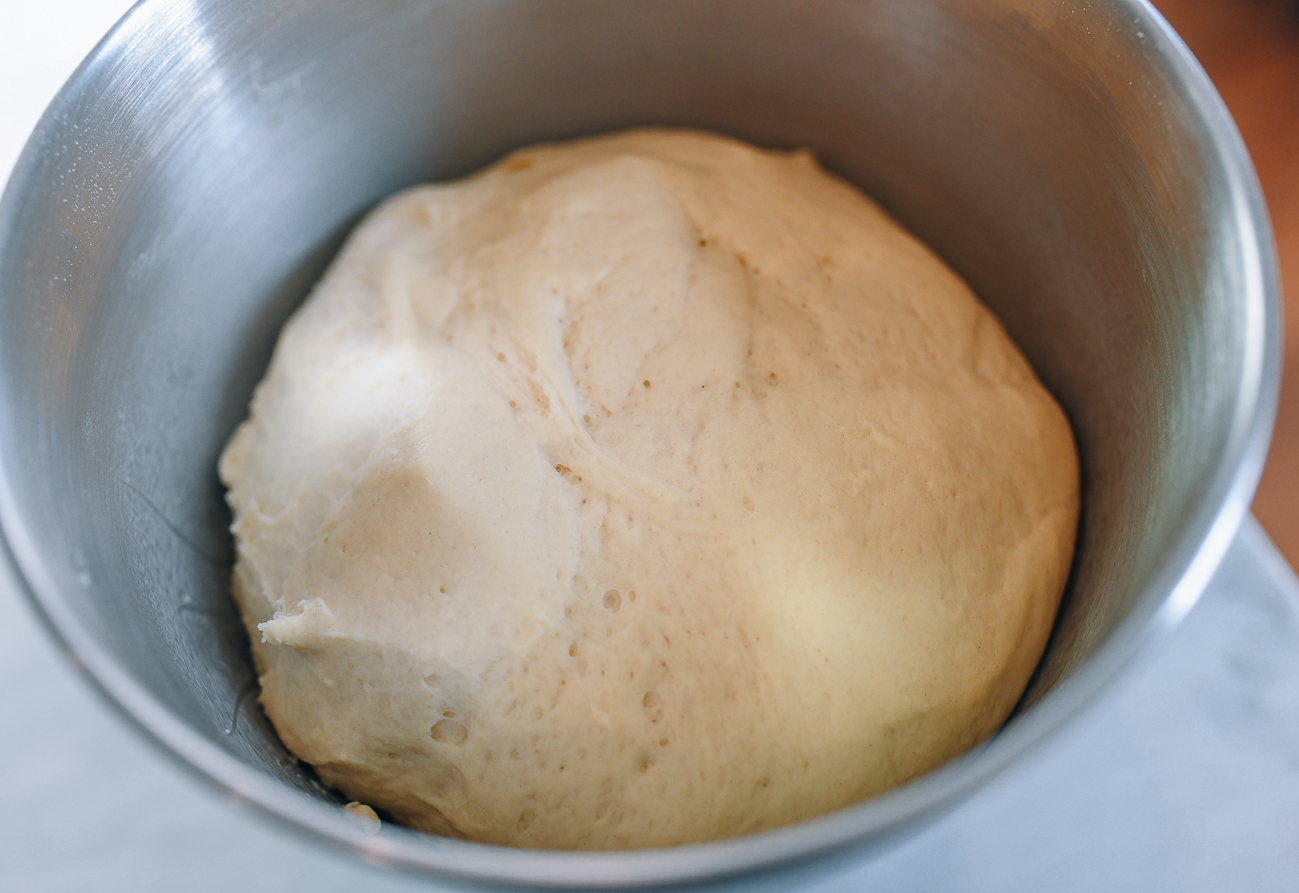
After the first proof, put the dough back in the mixer, and stir for another 5 minutes to punch the air out of it.
While that’s happening, mix the filling. In a medium bowl, combine the coconut, milk powder, sugar, salt, melted butter, egg yolks, and milk.
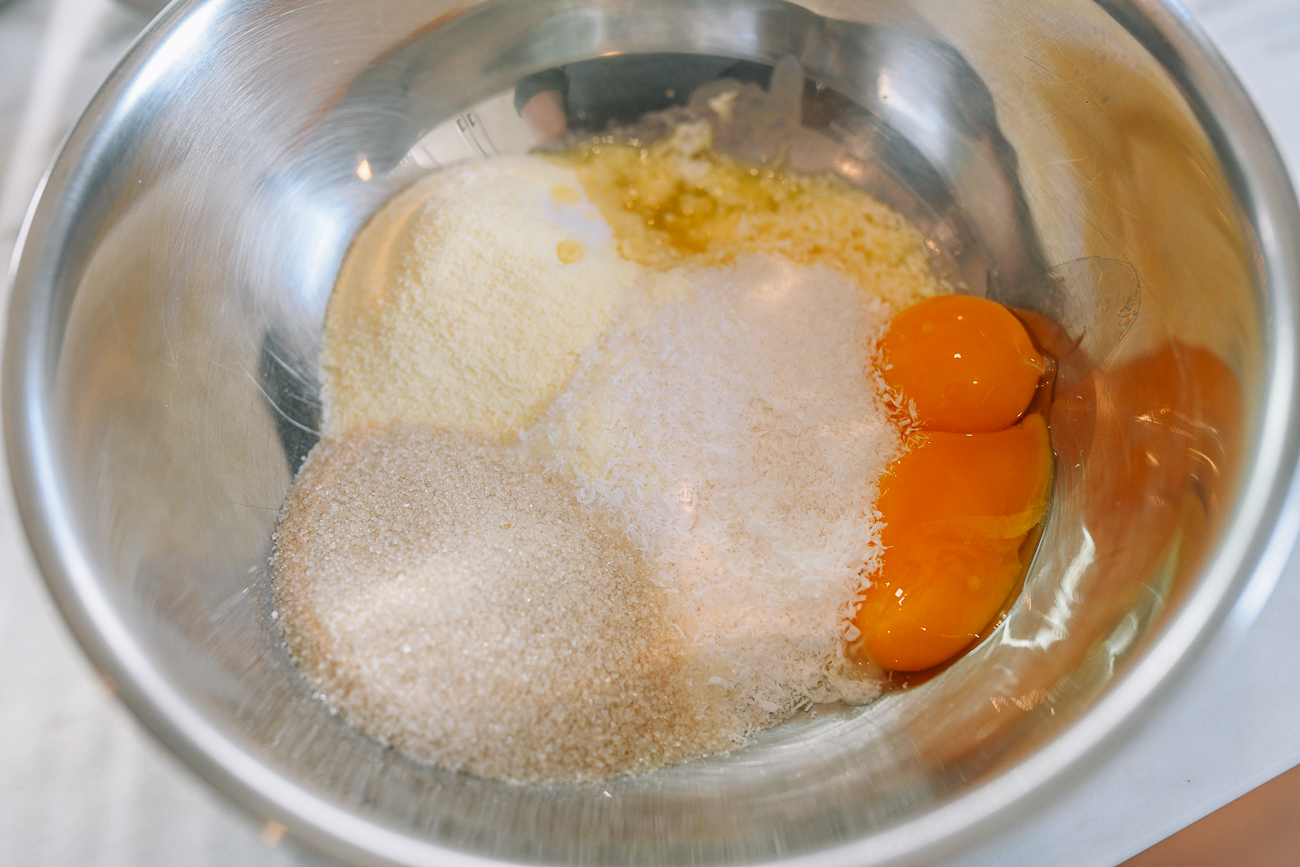
The texture of the filling should be moist enough to hold together, but shouldn’t be overly wet/paste-like.
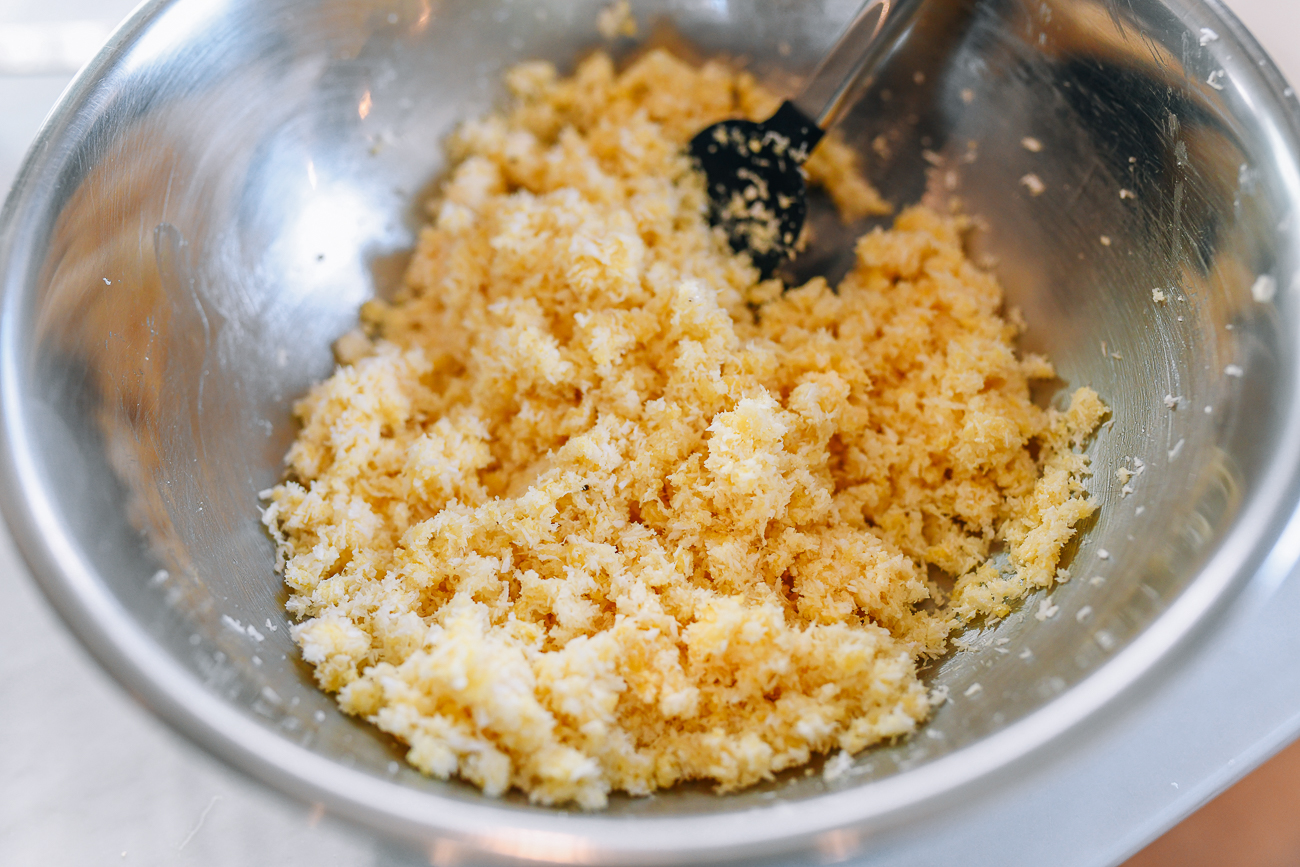
After the mixer has punched the air out of the dough (you can also do this by hand), dump it onto a lightly floured surface.
Shape it into a ball, and cut it in half. Cut each half of dough into 6 pieces, so you get 12 total pieces of dough.
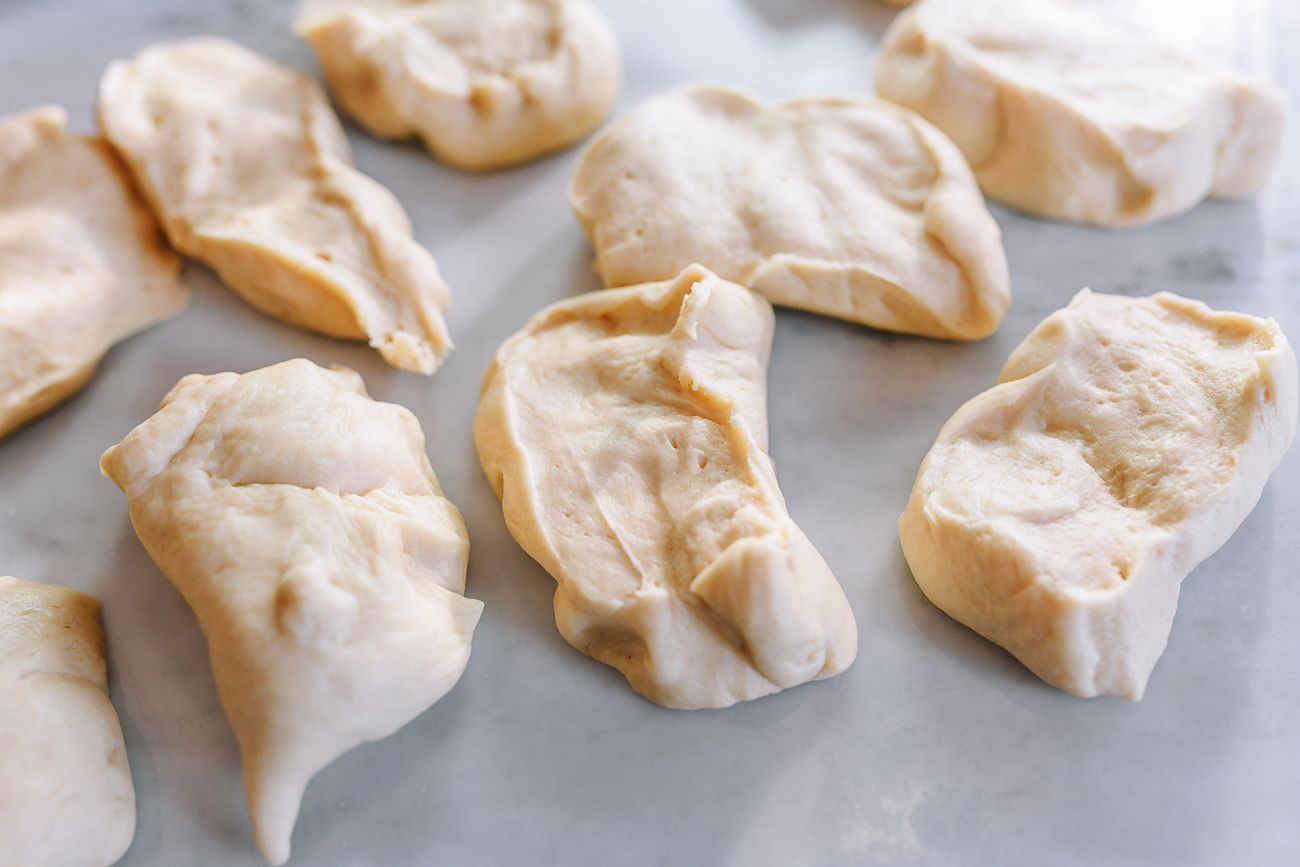
To shape the buns, knead and roll piece of dough into an even ball, and flatten.
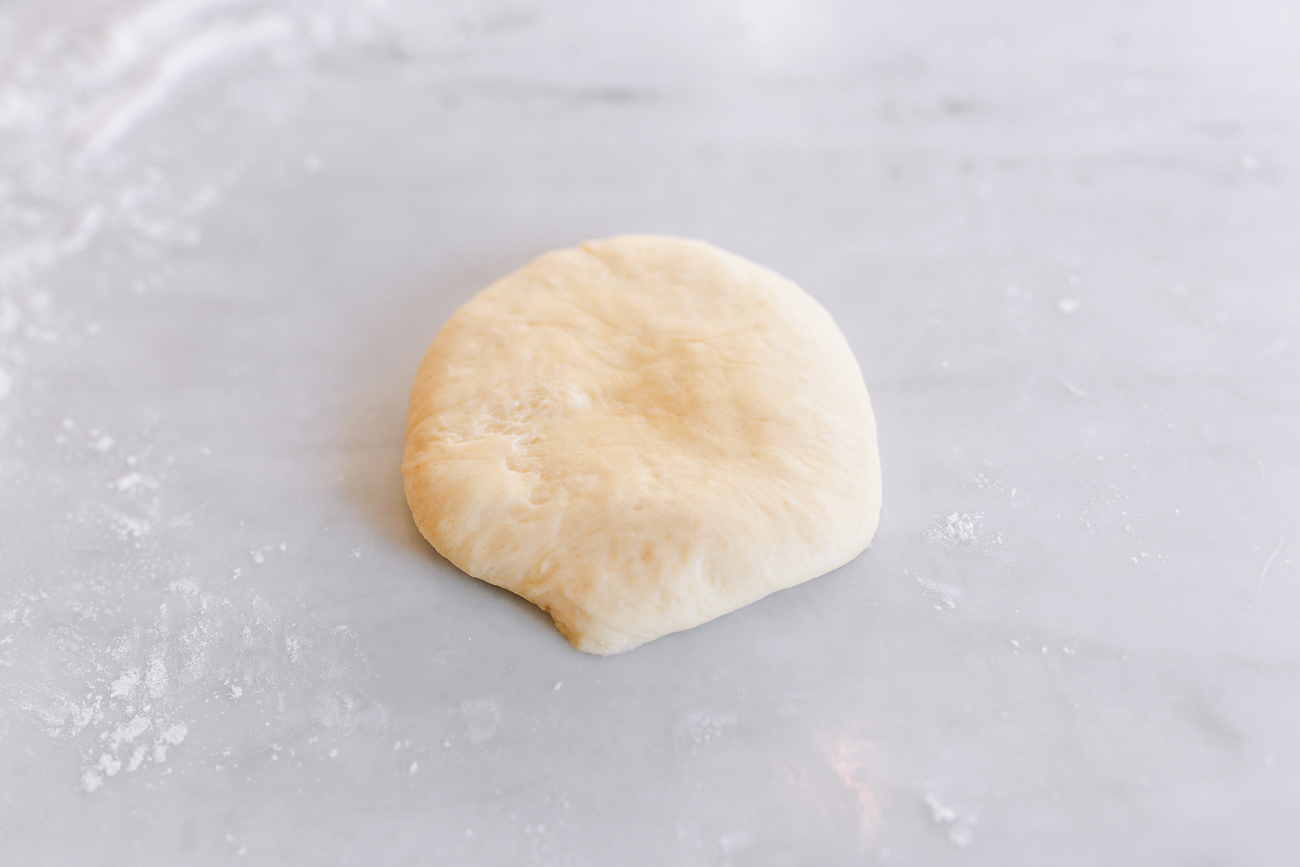
Roll the piece of dough out into a long rectangle, about 5×10 inches.
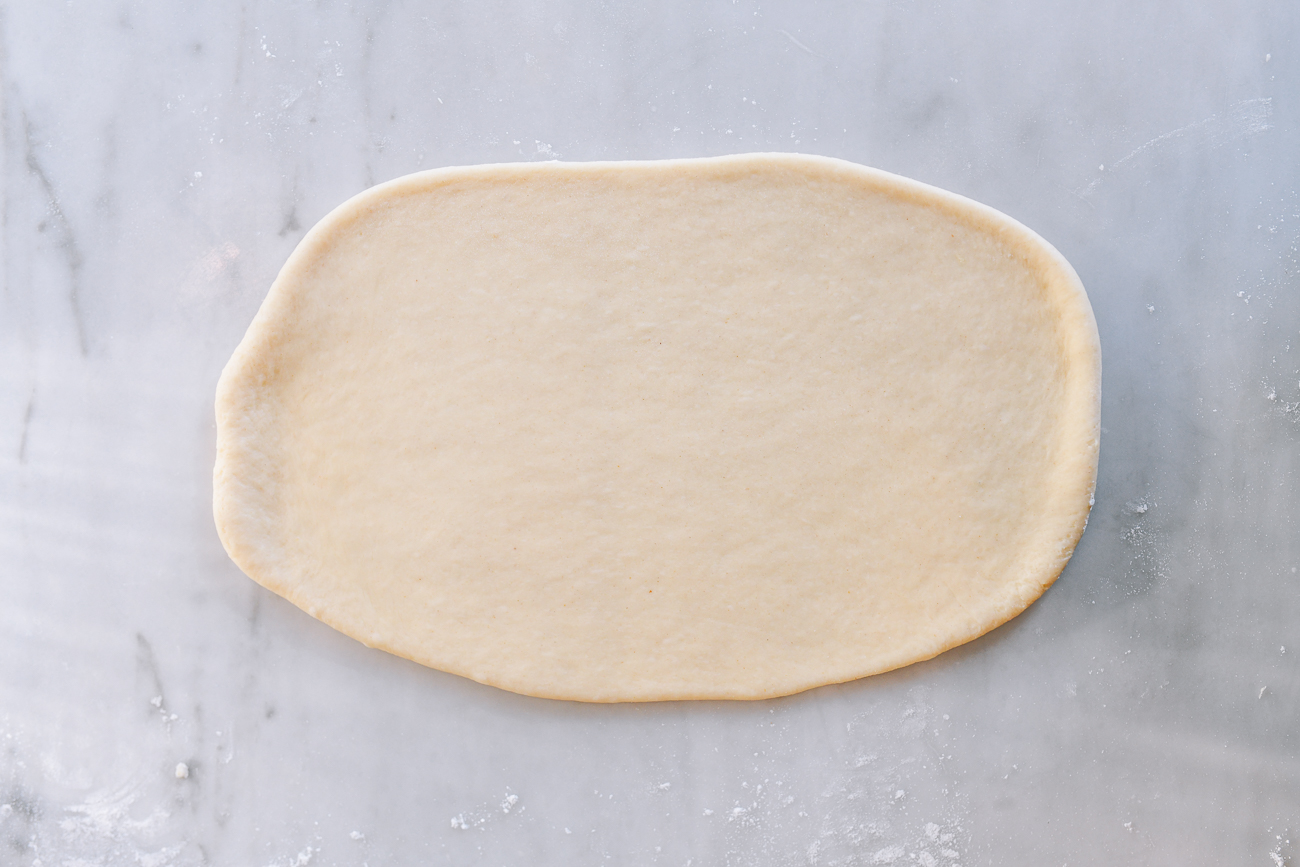
Spread a layer of filling onto the rectangle, pressing the filling into the dough and leaving about a half inch of margin all around.
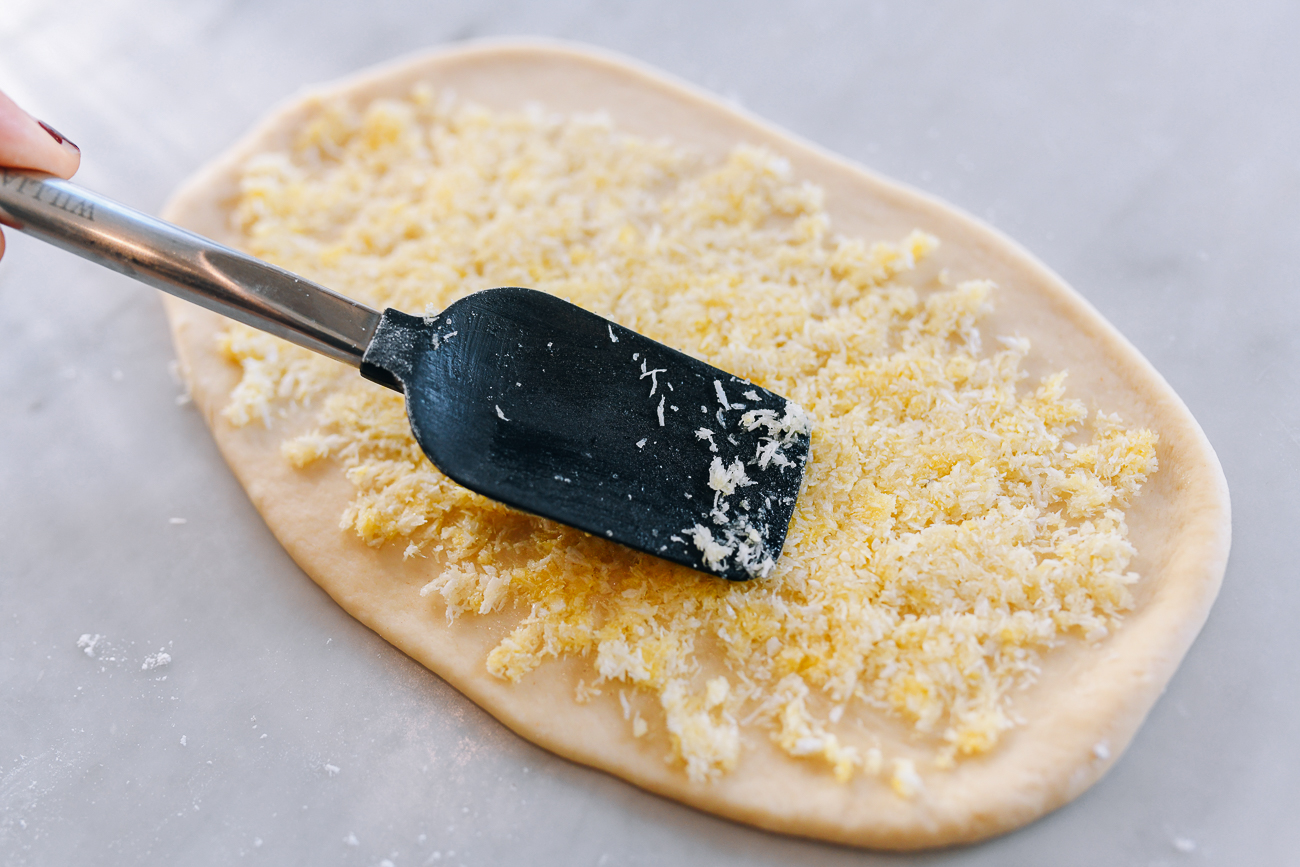
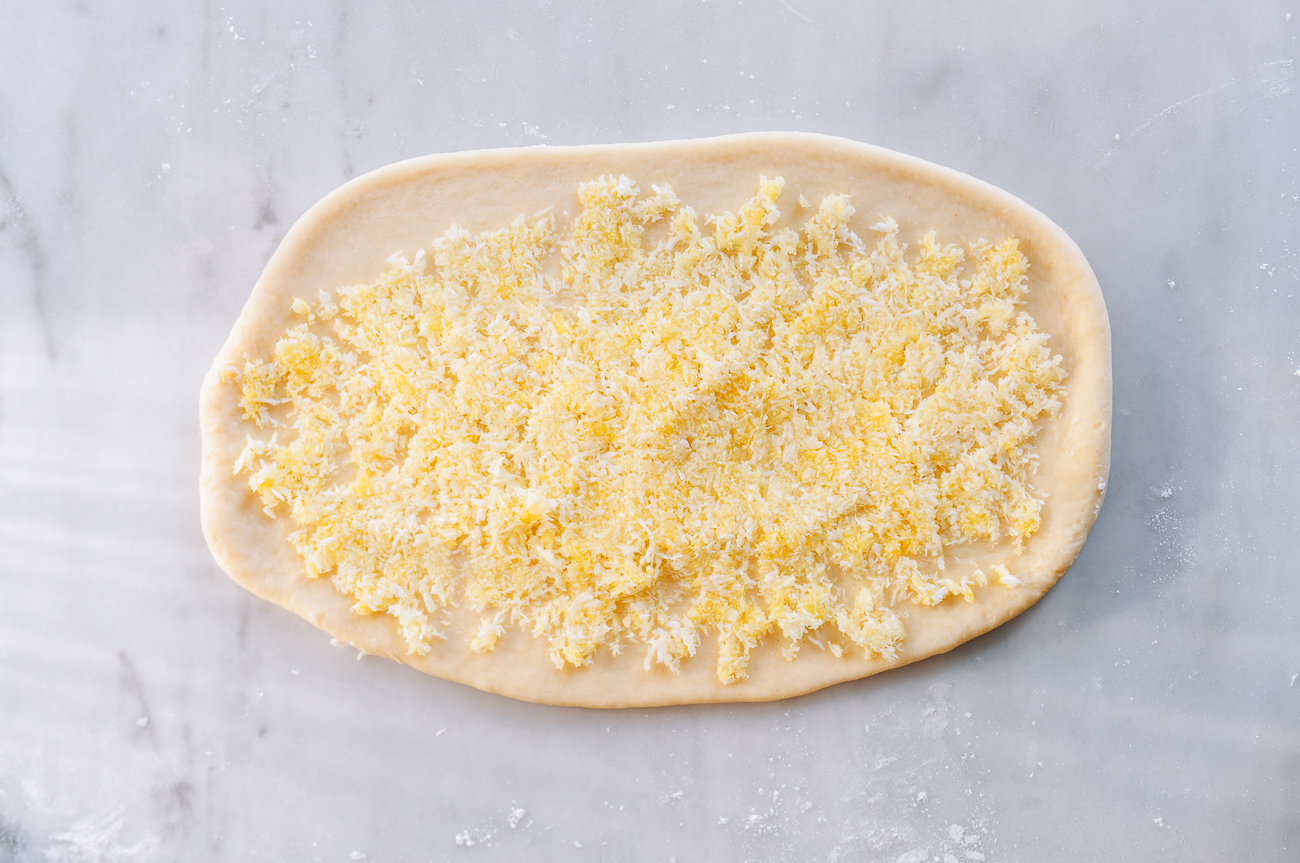
Roll the dough lengthwise into a cigar.
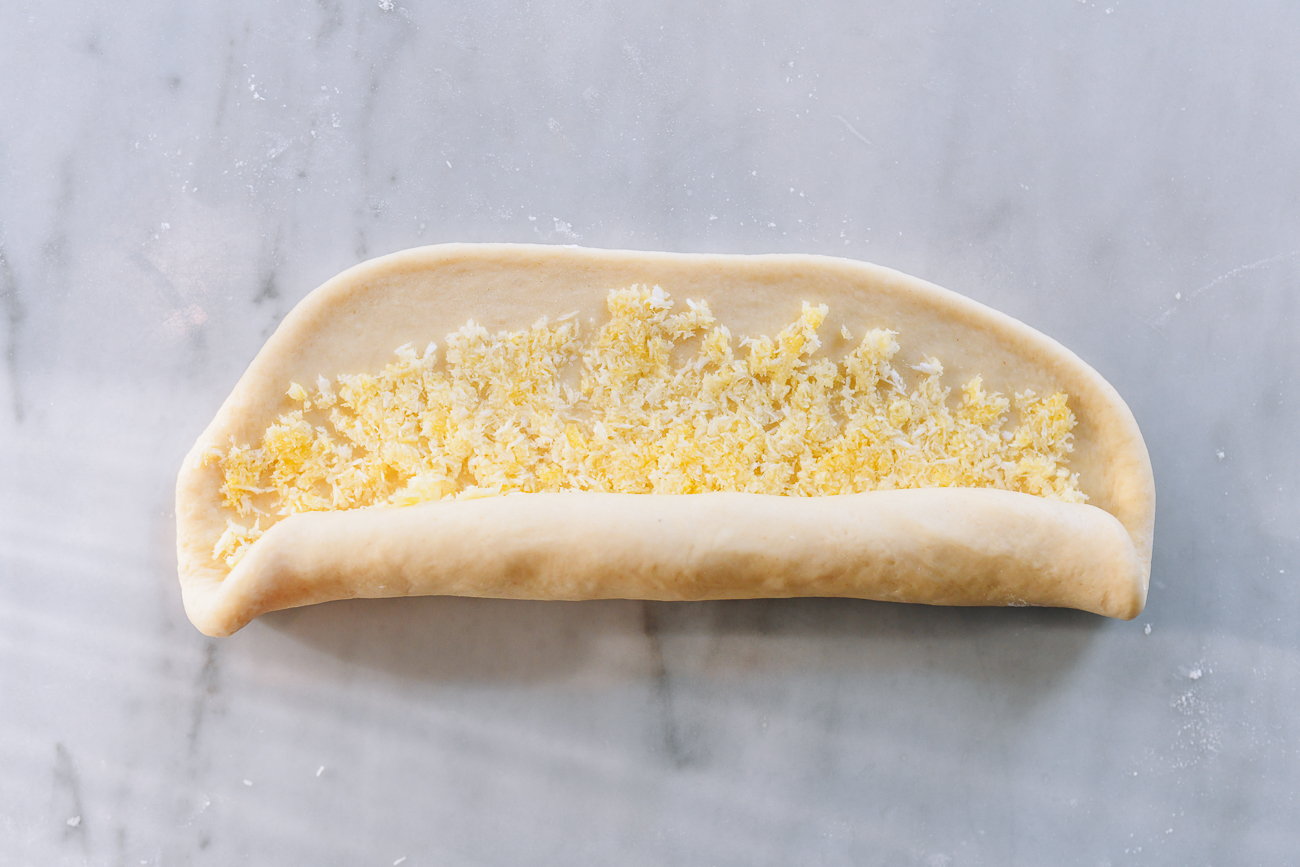
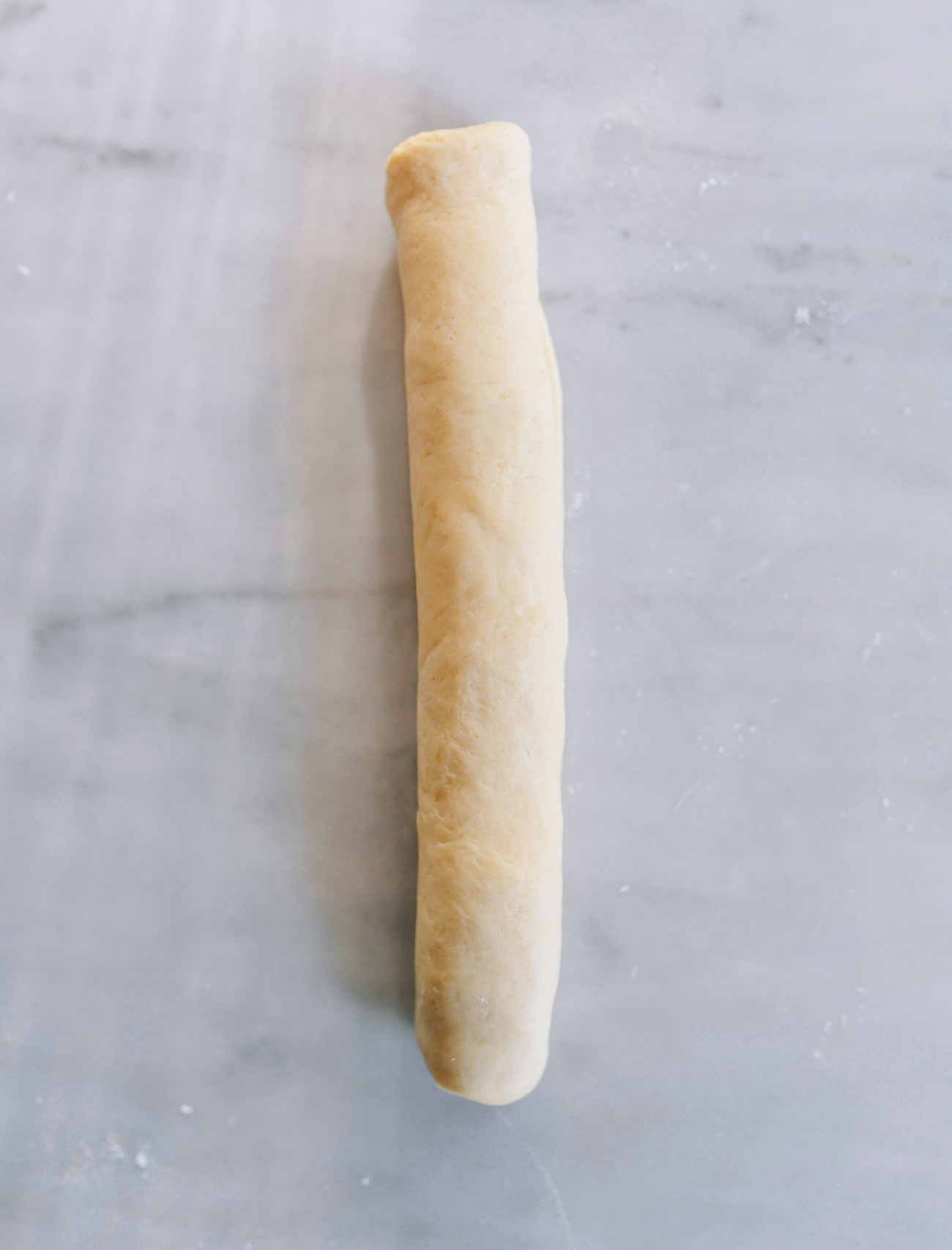
Cut the cigar in half lengthwise, leaving it attached at the top end, so it kind of looks like a long pair of pants.
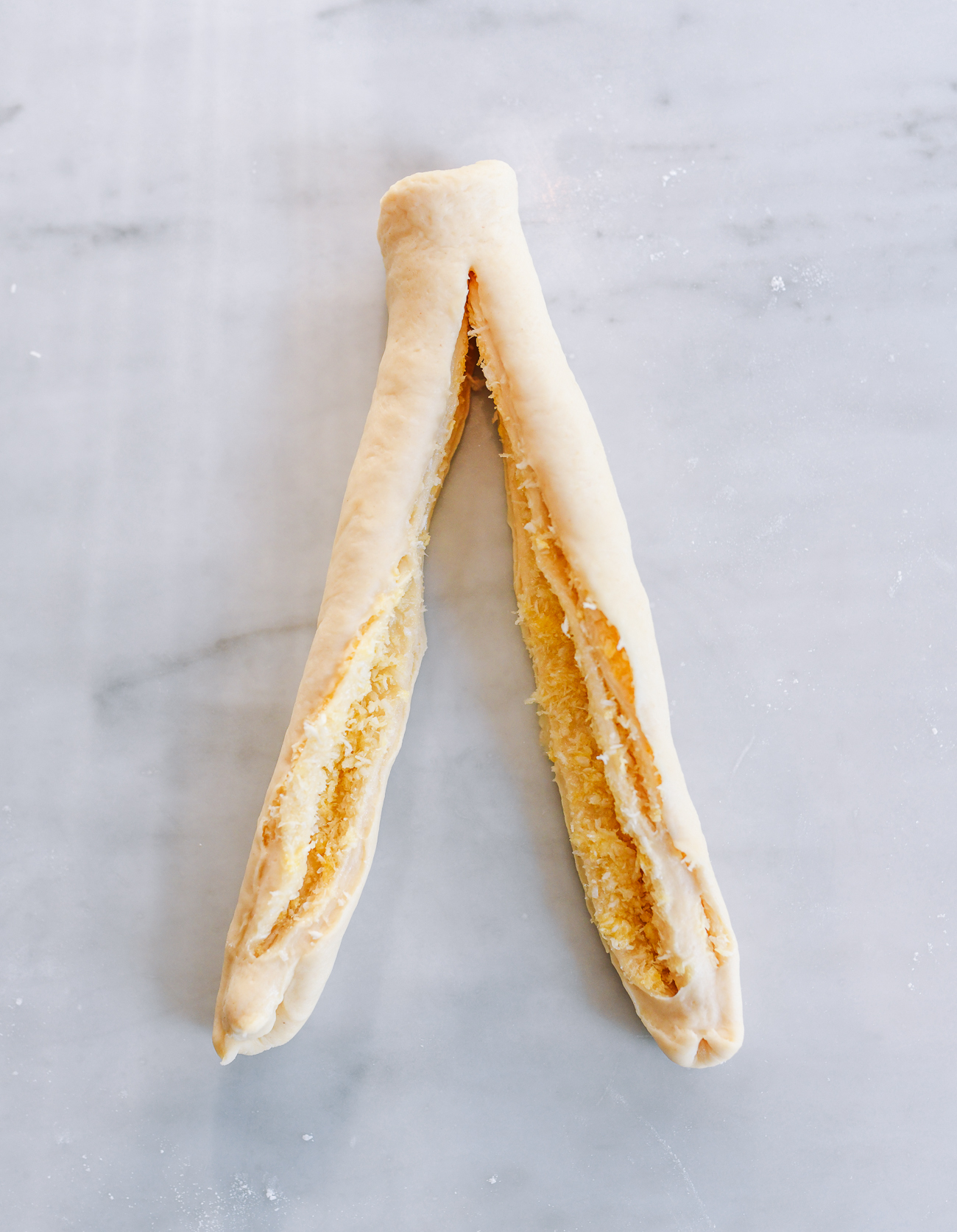
Twist the two pieces together…
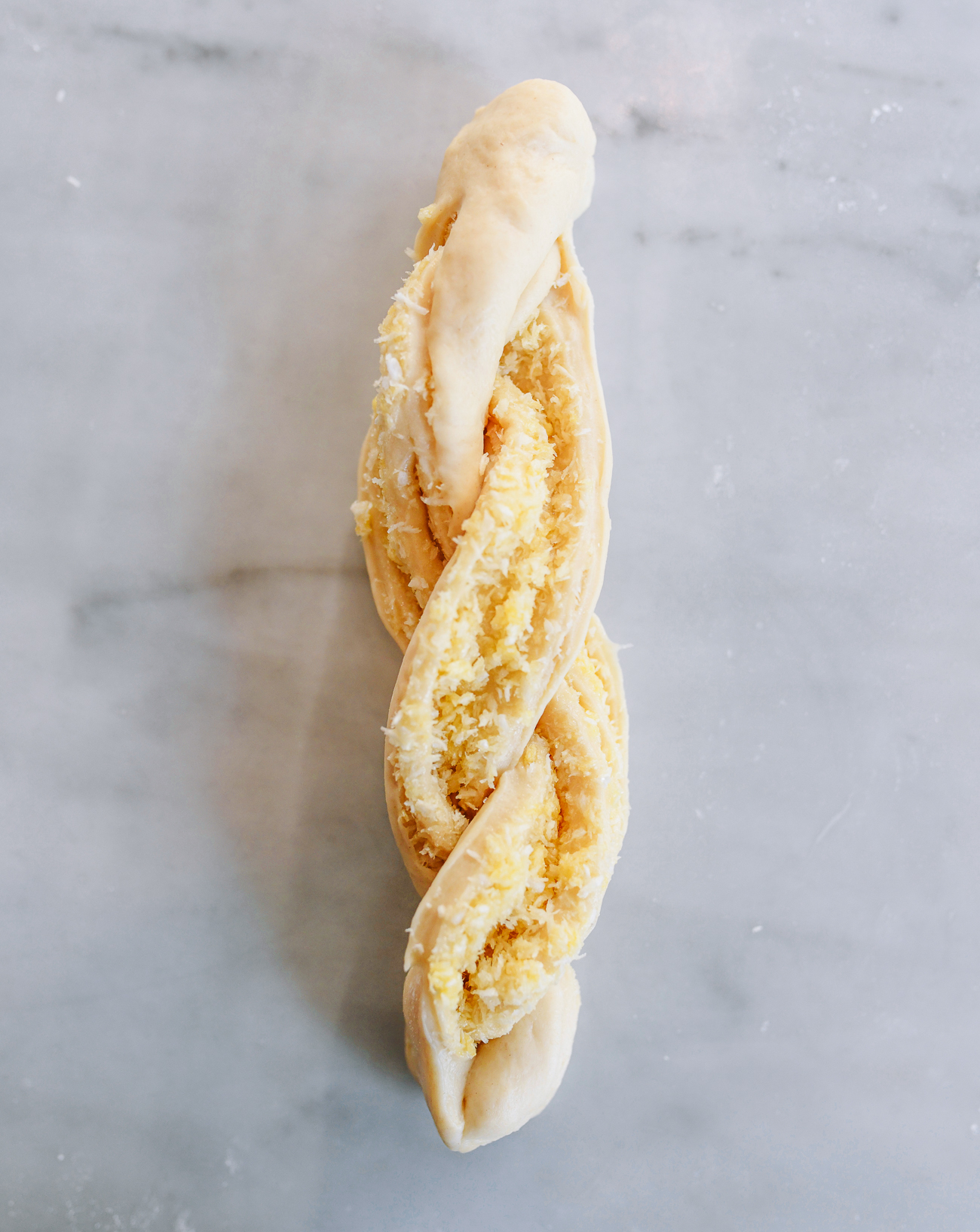
And then roll into a snail shape, tucking the ends underneath the bun. Place onto a parchment-lined baking sheet.
You’ll need two baking sheets, six buns per baking sheet.
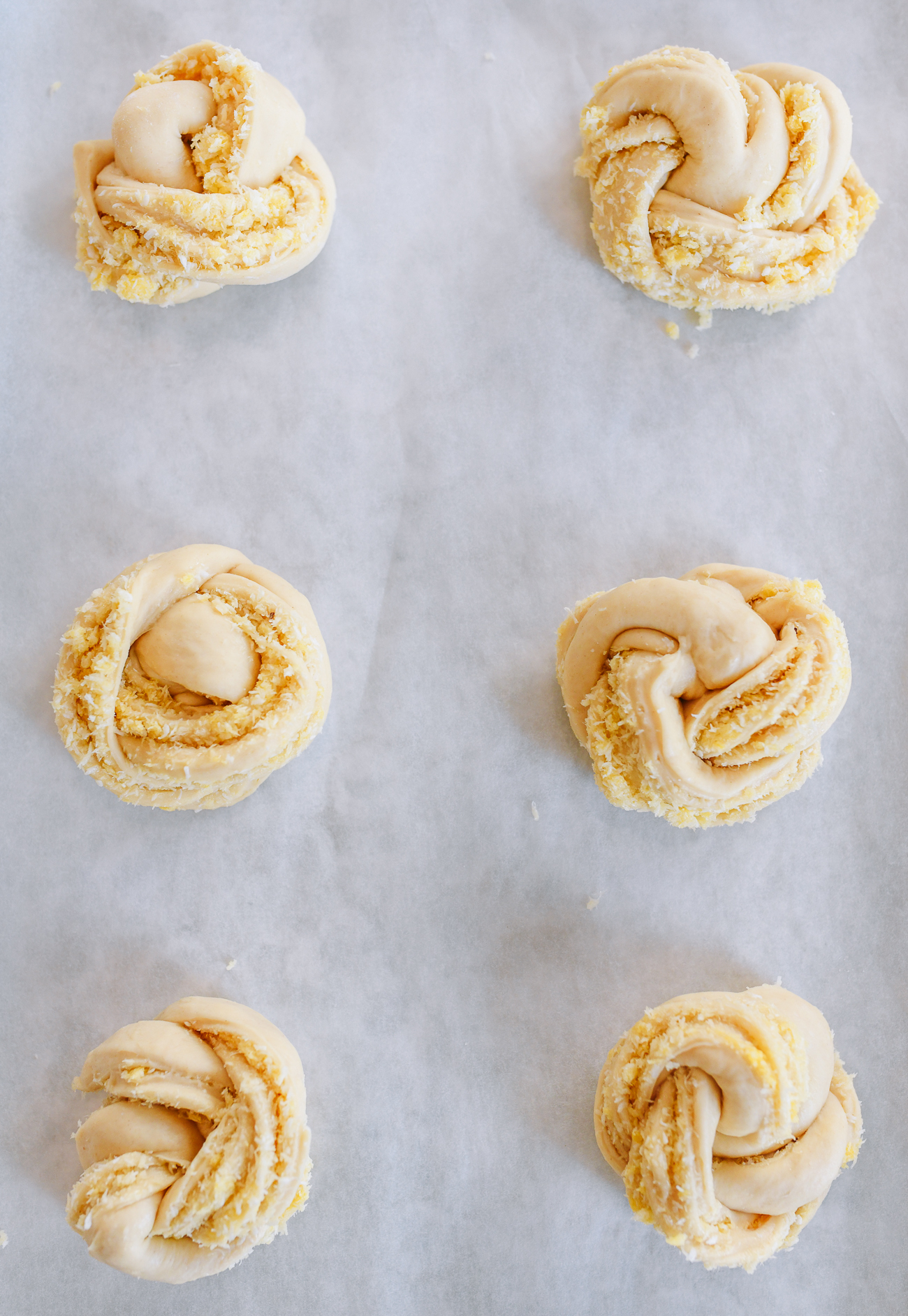
Cover with a damp towel, and proof the buns for 1 hour. Meanwhile, preheat the oven to 350 degrees, and position a rack in the middle of the oven.
Brush the risen buns with beaten egg.
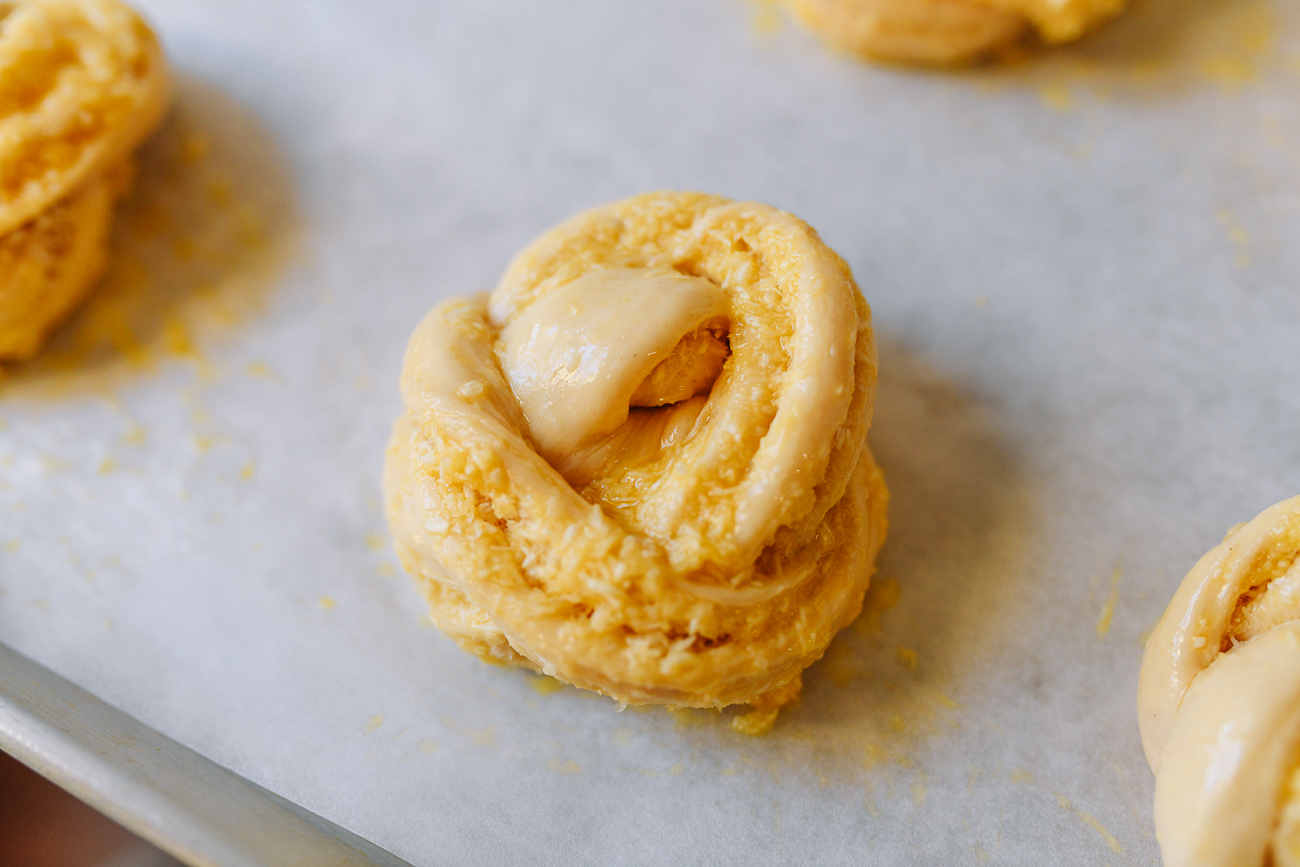
Bake for 20-25 minutes, until golden. Remove from the oven, and while the buns are still warm, brush with sugar solution.
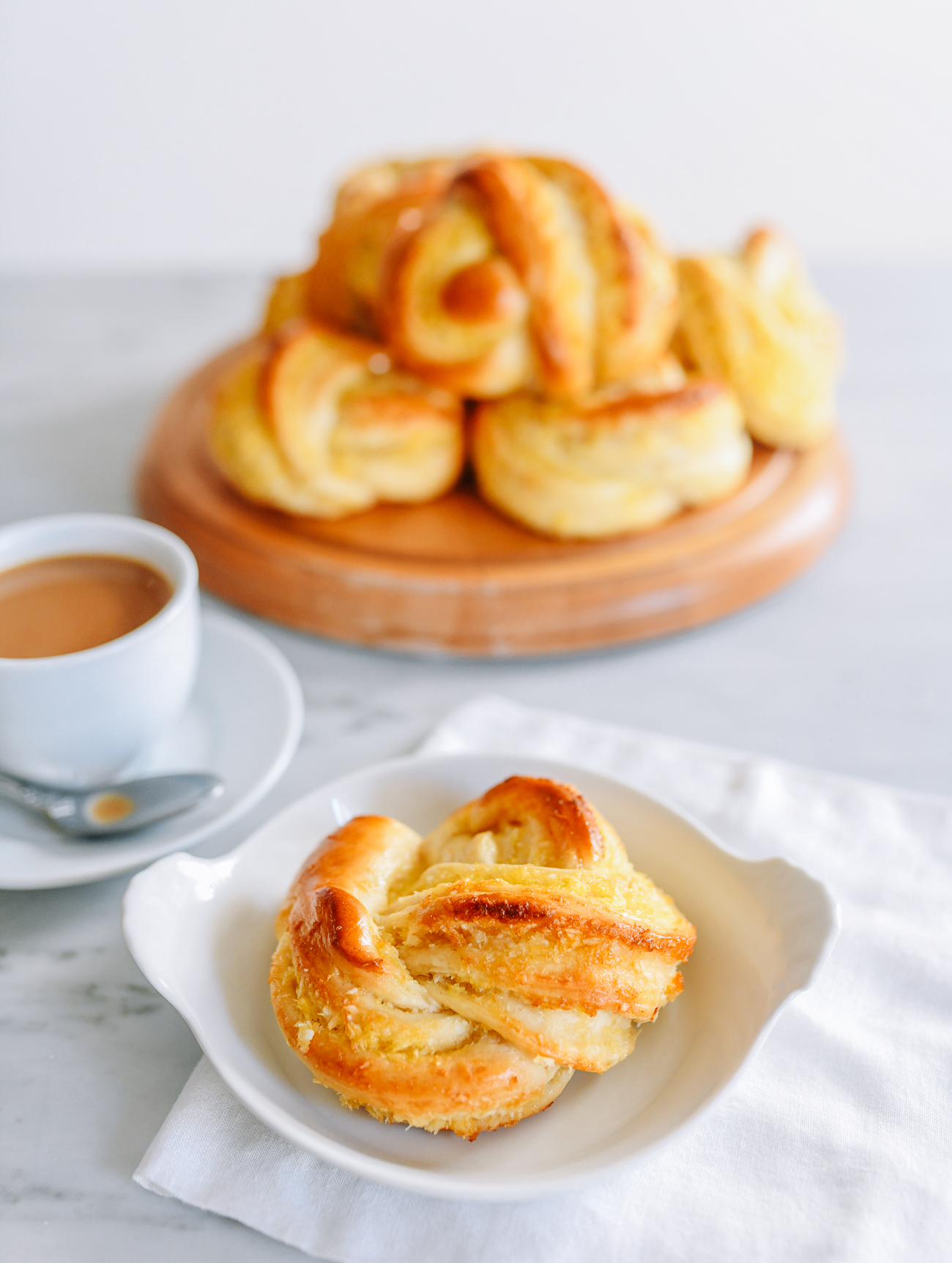
Enjoy your Inside Out Hong Kong Coconut Buns warm, with a nice cup of Hong Kong Milk Tea, Yuanyang Tea, or coffee!
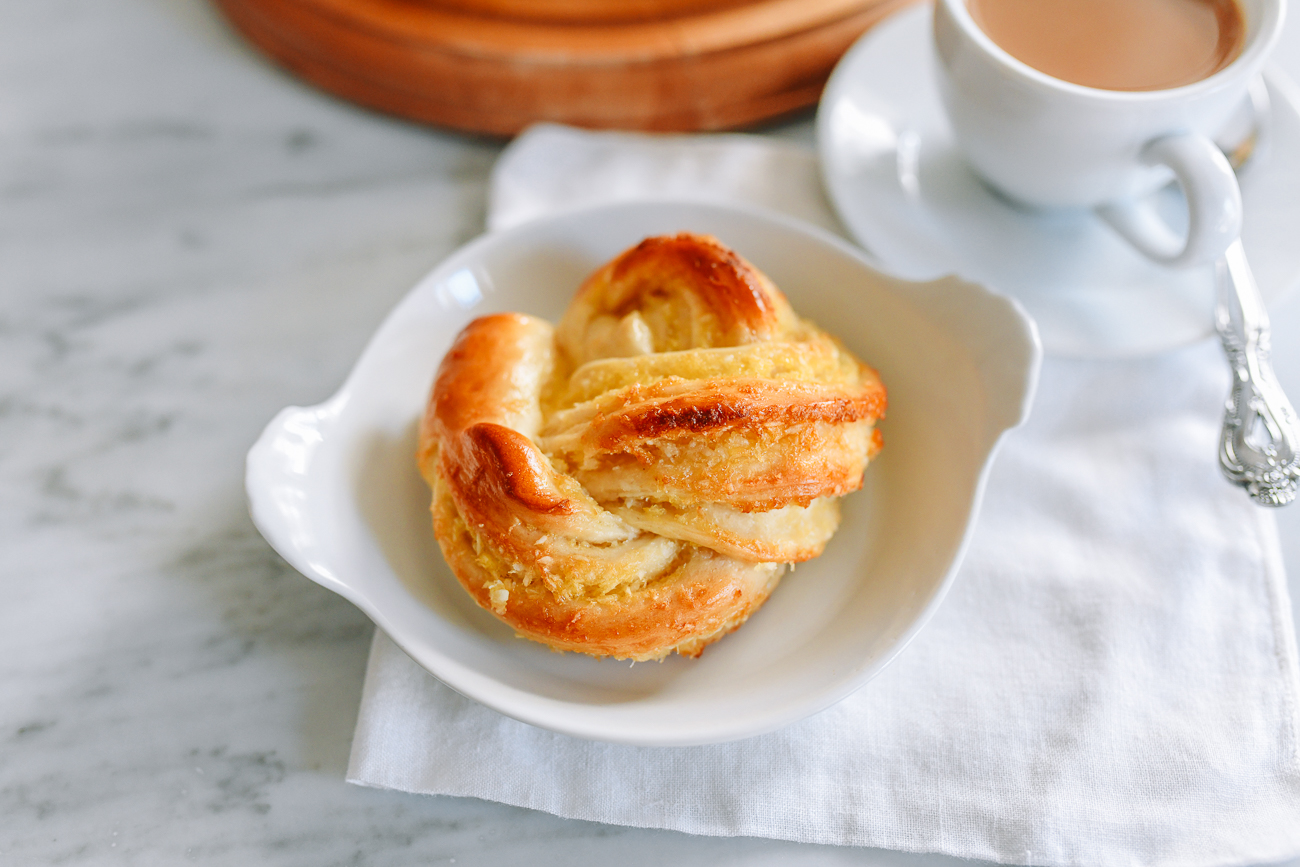
These buns are best enjoyed fresh and warm out of the oven. However, you can continue to enjoy them for 4-5 days.
Store these buns in an airtight container on the counter for 1-2 days, and then store in the refrigerator. Microwave for 30 seconds to soften/warm them up before enjoying.
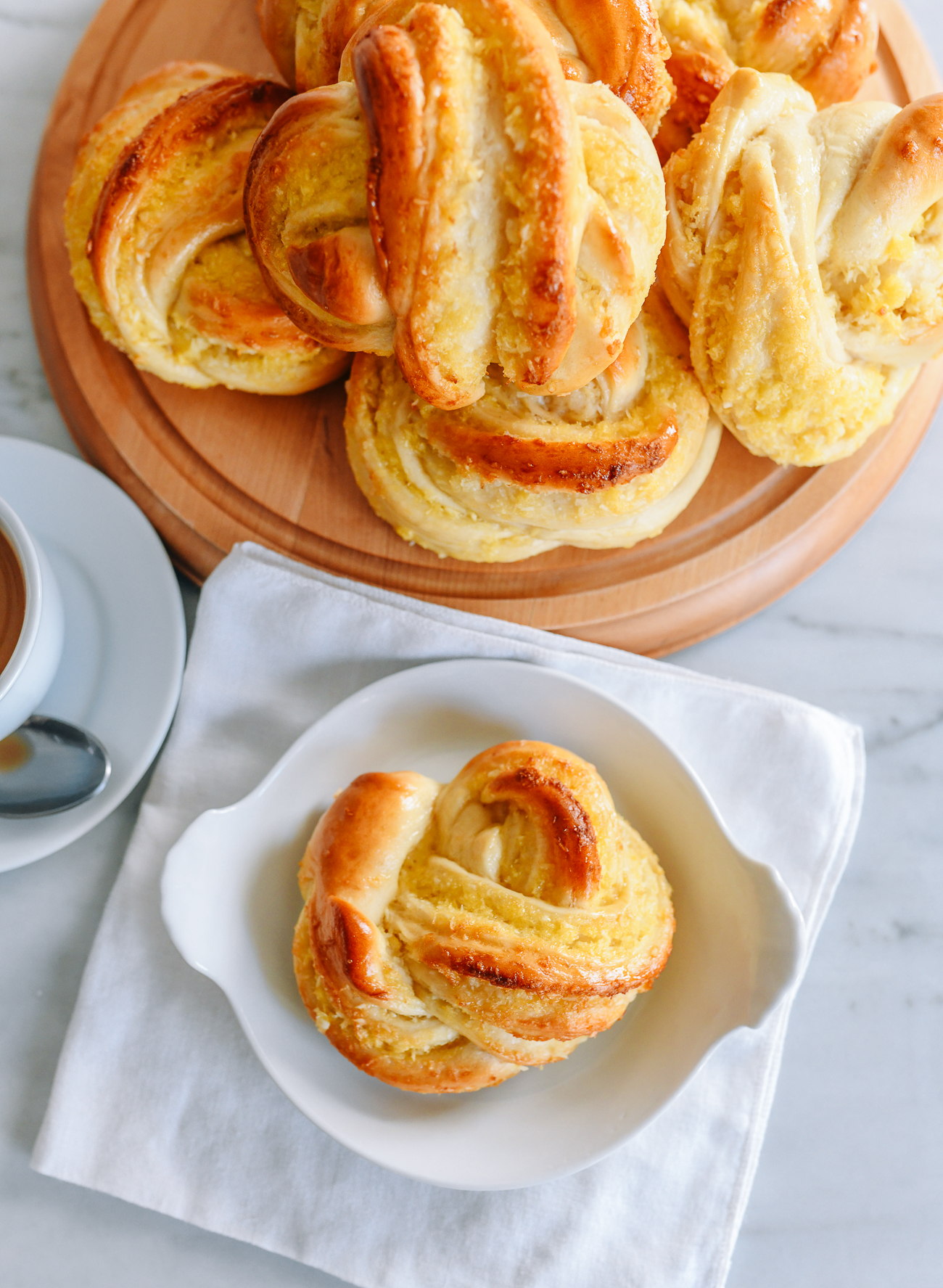
Inside-Out Hong Kong Coconut Buns
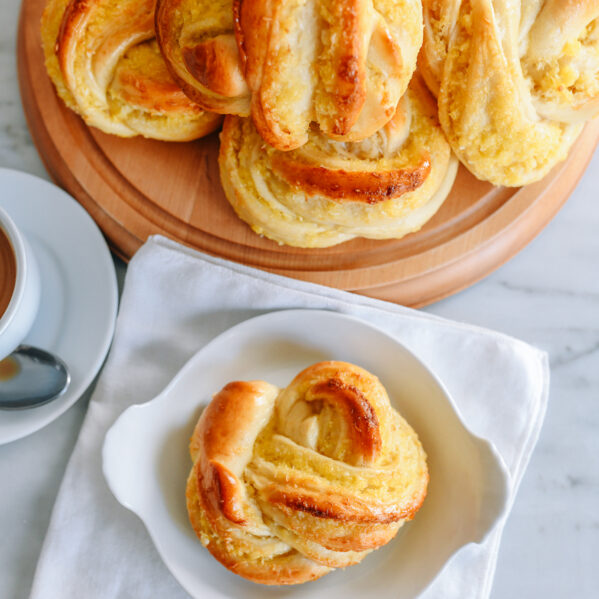
Ingredients
For the buns:
- 2/3 cup heavy cream (at room temperature)
- 1 cup milk (whole milk preferred, but you can use 2%, at room temperature)
- 1 large egg (at room temperature)
- 1/3 cup sugar
- 1/2 cup cake flour (can substitute 1/2 cup all purpose flour sifted with 1 tbsp cornstarch)
- 3 1/2 cups bread flour (tap measuring cup to avoid air pockets)
- 1 tablespoon active dry yeast
- 1 1/2 teaspoons salt
For the coconut filling:
- 1 ¼ cups sweetened coconut flakes (sweetened or unsweetened)
- 1/4 cup milk powder (non-fat or regular)
- 1/3 cup sugar
- 1/4 teaspoon salt
- 2 tablespoons butter (melted; salted or unsalted are both fine)
- 2 egg yolks
- 2 1/2 tablespoons milk
To finish the buns:
- 1 egg (beaten)
- 1 tablespoon sugar (dissolved in 1 tablespoon boiling water)
Instructions
- In the bowl of a stand mixer fitted with the dough hook attachment, add ingredients in the following order: heavy cream, milk, egg, sugar, cake flour, bread flour, yeast, and salt. Turn the mixer on to the lowest setting to bring the dough together. Knead on low speed for 15 minutes. If needed, turn off the mixer to bring the dough together with a rubber spatula.
- The dough should not stick to the sides of the mixer, but it may look a little bit sticky (sticking to the bottom of the mixer is ok). If you’re in a humid climate, and the dough is sticking to the sides of the mixing bowl, add more flour 1 tablespoon at a time until it comes together. Alternatively, you can stir all the dough ingredients together with a wooden spoon in a large mixing bowl, and then knead by hand for 20 minutes.
- Shape the dough into a ball, and cover the bowl with an overturned plate or damp towel. Place in a warm spot to proof for 75-90 minutes, or until the dough doubles in size. (A good proofing environment is a closed microwave, with a mug of hot boiled water next to the bowl.)
- While that's happening, mix the filling. In a medium bowl, combine the coconut, milk powder, sugar, salt, melted butter, egg yolks, and milk. Set aside.
- After the first proof, knead for another 5 minutes to punch the air out of it. Then dump the dough on a lightly floured surface, shape it into a ball, and cut it in half. Cut each half of dough into 6 pieces, so you get 12 equal pieces of dough.
- To shape the buns, knead and roll piece of dough into an even ball, and flatten. Roll into a 5×10 inch rectangle. Spread a layer of filling onto the rectangle, pressing the filling into the dough and leaving about a half inch of margin all around.
- Roll the dough lengthwise into a cigar. Cut the cigar in half lengthwise, leaving it attached at the top end, so it looks like a long pair of pants. Twist the two pieces together, and then roll into a round spiral/snail shape, tucking the ends underneath the bun. Place onto a parchment-lined baking sheet. You’ll need two baking sheets, with 6 buns on each.
- Cover with a damp towel, and proof the buns for 1 hour. Meanwhile, preheat the oven to 350 degrees, and position a rack in the middle of the oven.
- Brush the risen buns with beaten egg, and bake for 22-26 minutes, until golden. Remove from the oven, and while the buns are still warm, brush with sugar solution.
